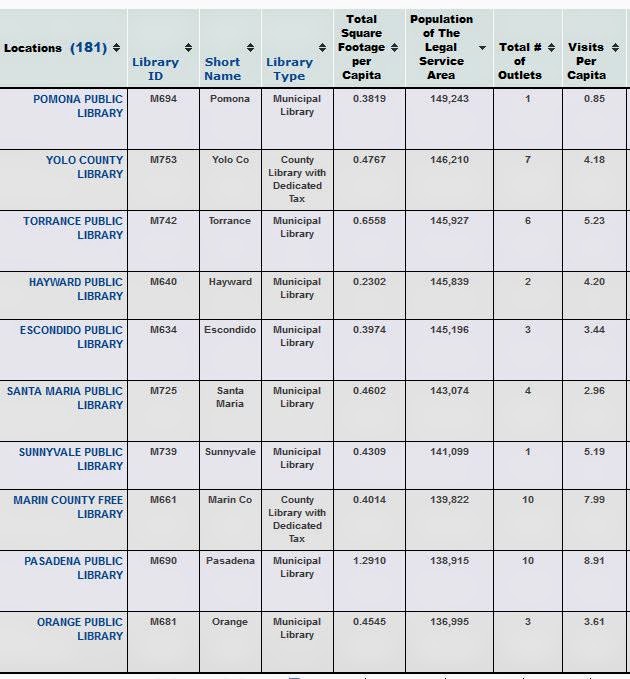Last time I looked at the cost to increase Sunnyvale's
library facilities to the size per capita of similar nearby cities by building
branch libraries vs. tearing down the existing one and building a new
one. The numbers were:
Using $500/sq ft
1. 50K sq. ft more - branch libraries = 110K sq. ft.
total = $25M = $1.5M/yr @ 2% bond interest (match Mtn Vu's space/person)
2. 87K sq. ft more - branch libraries = 147K sq. ft.
total = $44M = $2.7M/yr @ 2% bond interest (match San Mateo's space/person)
3. ABA 2007 proposal: 81K sq. ft more space in one main library = 141K sq. ft. total = $81M =
$5.0M/yr @ 2% bond interest. Since they proposed to tear down 60K sq. ft. the cost for the additional 81K sq.
ft. would have been $81M/81K sq. ft. = $1,000/sq ft.
There is another option for expanding facility space. We could form joint school-city libraries at any of the many school libraries in town. This has been and is being done throughout the world. Publications on how to do it include:
"Is a Combined School/Public Library Right for Your Community? A Guide for Decision Makers" by the State Library of Iowa available at:
http://www.statelibraryofiowa.org/ld/q-s/school-librarians/combined-sch-pl/guide/view
"Combined School and Public Libraries Guidelines for Decision Making, Second Edition" by Wisconsin Department of Public Instruction available at:
http://dpi.wi.gov/pld/pdf/comblibs.pdf
The Iowa publication on page 24 shows a number of combined libraries and shows that they save money on a per capita basis, sometimes quite a bit. In the Wisconsin publication they give brief descriptions of how selected combined libraries work (pg 18 ff). There is sharing and collaboration along reasonable lines that are pretty much what you would expect.
There will be severe cutbacks in school funding if the tax measure doesn't pass this November. The first to get cut may well be school librarians who are becoming an endangered species in some states. The city already pays for some athletic coaching for the public schools, it could take on the library staff of say Columbia Middle School and perhaps an elementary school or two in return for having public access during non-school hours and school vacations. This could be a real win-win with cheap public branch libraries for the public while helping out the public schools.
These are difficult economic times. We should be creative.
There is another option for expanding facility space. We could form joint school-city libraries at any of the many school libraries in town. This has been and is being done throughout the world. Publications on how to do it include:
"Is a Combined School/Public Library Right for Your Community? A Guide for Decision Makers" by the State Library of Iowa available at:
http://www.statelibraryofiowa.org/ld/q-s/school-librarians/combined-sch-pl/guide/view
"Combined School and Public Libraries Guidelines for Decision Making, Second Edition" by Wisconsin Department of Public Instruction available at:
http://dpi.wi.gov/pld/pdf/comblibs.pdf
The Iowa publication on page 24 shows a number of combined libraries and shows that they save money on a per capita basis, sometimes quite a bit. In the Wisconsin publication they give brief descriptions of how selected combined libraries work (pg 18 ff). There is sharing and collaboration along reasonable lines that are pretty much what you would expect.
There will be severe cutbacks in school funding if the tax measure doesn't pass this November. The first to get cut may well be school librarians who are becoming an endangered species in some states. The city already pays for some athletic coaching for the public schools, it could take on the library staff of say Columbia Middle School and perhaps an elementary school or two in return for having public access during non-school hours and school vacations. This could be a real win-win with cheap public branch libraries for the public while helping out the public schools.
These are difficult economic times. We should be creative.











